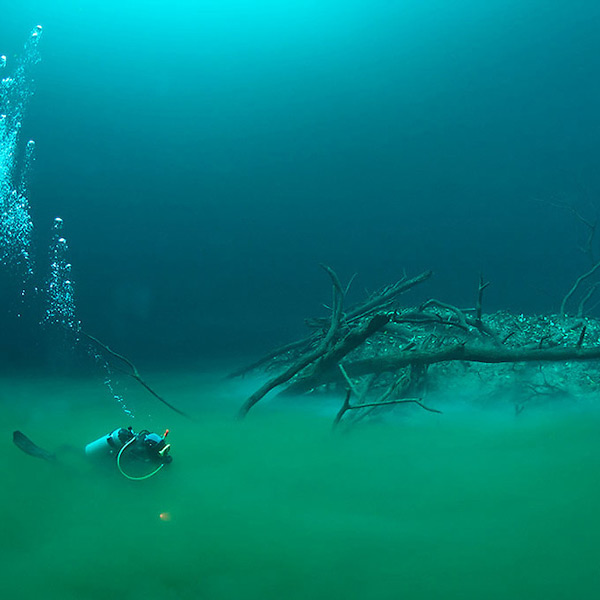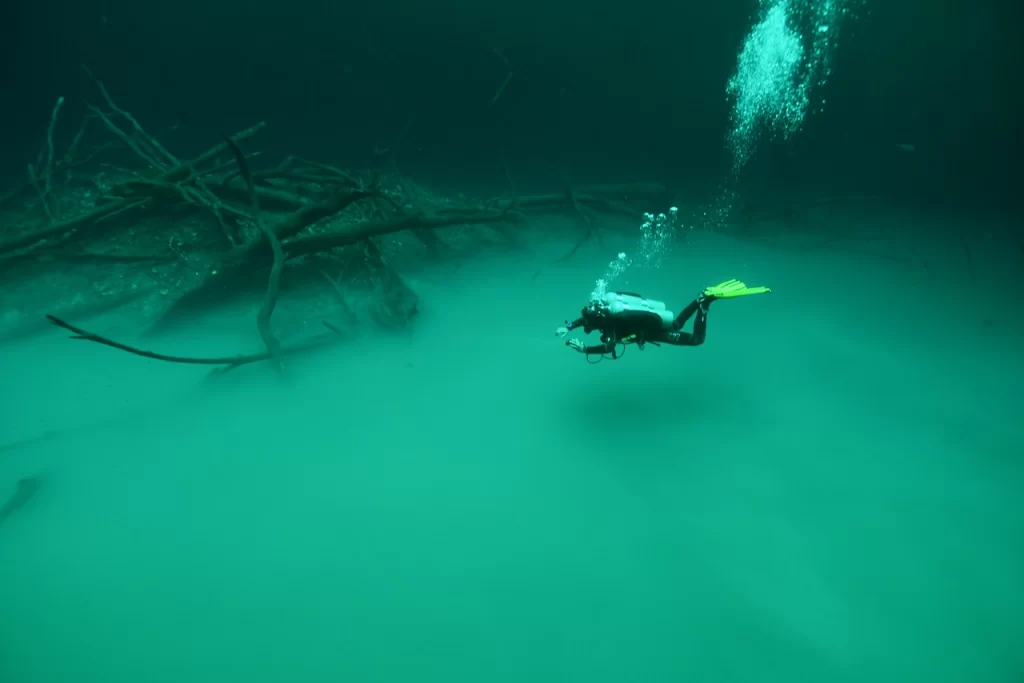Chilling Depths: The Haunting Tale of Lucia’s Descent into the Abyss of Cenote Angelita


| Incident Location | Diver Full Name |
|---|---|
| Mexico, Tulum, Cenote Angelita | Lucia Russell |
Deep within the Mayan jungles beyond the town of Tulum, Mexico, lies a dense green forest that opens up to reveal a remarkable sight—a circular hole measuring about 200 feet in diameter. Its depth almost matches its width, locally known as the Cenote. This sinkhole harbors one of the most captivating dive spots in the entire world—its name is Angelita. It has an enchanting quality that brings about feelings of mystery and a touch of spookiness. However, exploring this cave is no easy feat. At first, as you descend, the water appears crystal clear, offering visibility up to 65 feet below. But as you go deeper, the water turns increasingly murky, making the surroundings feel like an underworld. The dive takes you as far down as 200 feet beneath the water’s surface, making it a dive reserved only for the most seasoned and experienced divers.
The Unique Features of Cenote Angelita
The Cenote Angelita harbors a fascinating marvel—the Angelita river right within the sinkhole. It features various unique layers where fresh water and salt water come together, alternating in distinct patterns. The river looks even more beautiful because of the colorful leaves and branches from nearby trees. These tree parts float along the river’s edges because the water is thick. The most incredible thing about this river is a thick cloud of hydrogen sulfide that is about four and a half feet wide and stretches around 98 feet. The gases gather where fresh water and salt water meet, creating a false bottom at the river’s bottom. You can cross this false bottom and reach a dark and otherworldly chamber filled with jungle debris. The base of this debris mountain starts below the cloud but reaches above it. When you rise from below the cloud, you’ll see the peak of the debris mountain take on a new appearance, like you’re climbing a mountain covered with clouds. It’s like being in a magical place unlike anything else you’ve experienced.
Lucia and Ricardo’s Exploration
Lucia Russell grew up as an inquisitive child, always on the hunt for the next new adventure. At age nine, she was known to be an amazing swimmer. At 19, after seeing a cave diving show, she developed her skills and devoted her time to becoming a cave diver. After registering for training, she met Ricardo Felipe, and they became best friends. They were both in the same diving class and got certified together. After being certified, they made a bucket list of caves they would explore together. Since then, they have been diving buddies, exploring different dive sites in Mexico, including Cenote El Pete, Cenote dos oyos, and Grand Cenote. Lucia and Ricardo had Cenote Angelita next on their list of places to explore. They were excited to witness the famous thick hydrogen sulfide cloud at a depth of 98 feet. They got ready for their dive, and the much-anticipated day finally came.
The Dive into Cenote Angelita
After a short walk through the jungle from the car park, they arrived at a large lake. Before taking the plunge, they put on all their diving equipment on the simple benches provided in the jungle. Fully geared up, they began their journey down the dirt trail leading to the Cenote. When they reached the cenote’s edge, they took a bold leap off the simple wooden dock, propelling themselves into the mysterious depths of the Mayan underworld. The adventure had just begun, and they were eager to explore the wonders that lay ahead. As they began their descent into the Cenote, the water appeared hazy for the first 32 to 49 feet. The haziness was due to the organic material falling from the lush surroundings of the Cenote. It felt eerie right from the start, making them understand the belief held by the ancient Mayans—the cenotes were entrances to the underworld. As they delved deeper into the Cenote, the haze gradually cleared, revealing the mesmerizing spectacle the Cenote Angelita is known for—the famous hydrogen sulfide layer.
The Astonishing Hydrogen Sulfide Layer

As they continued their descent, Lucia and Ricardo finally reached a depth of 98 feet, right in the magical cloud of hydrogen sulfide. They were amazed by the extraordinary sight—something they could never have imagined. Truly, there was nothing else quite like it anywhere in the world. This unique cloud was no ordinary gas; it was a dense and thick hydrogen sulfide cloud suspended in Cenote Angelita. The origin of this remarkable cloud became clear to them—it formed from plant materials falling into the Cenote and breaking down, releasing hydrogen sulfide gas. This was unlike other cenotes they had seen before, such as lpete, where only a thin cloud exists. But here in Cenote Angelita, the cloud took on a denser and more substantial form. They noticed rocks and rubble emerging from the cloud, forming what seemed like a mountain or mound in the Cenote. This mound is called a Talus cone, a fancy term for a debris mount. It was a remnant of the collapsed cenote covering, adding to the intriguing beauty of this underwater wonderland.
Exploring the Mysterious Site
Apart from its creepy appearance, the hydrogen sulfide is also known to have a pungent and sulfurous smell, much like rotten eggs. However, since they were breathing compressed air from their dive tanks, it was safe for them to dive in and around the hydrogen sulfide. Under this thick cloud, the light was almost entirely blocked, causing the surroundings to be nearly pitch black. It was due to this darkness that Lucia and Ricardo decided to limit their dive depths to just 98 feet, which was the general depth for most dives. Beyond this point, it’s a dangerous dive site suitable for more advanced divers. Those who want to dive below the cloud must ensure their dive light is switched on to help them navigate through the darkness. Additionally, they must keep a close eye on their depths to ensure a safe and controlled exploration.
A Tragic Turn of Events
After an amazing time of exploration, the two divers signaled to each other that it was time to start their ascent. With another dive site successfully completed, they felt a sense of accomplishment as they ascended. They were set to follow the proper diving procedures to ensure their safety. They would pause for a deep stop at around 49 feet, allowing their bodies to adjust to the changing pressure. This stop would last for about two and a half minutes, ensuring that they minimized the risk of decompression sickness. They would then continue their ascent until they gradually reached a depth of 15 to 20 feet, where they would perform their final safety stop. During this three to five-minute stop, they would release any remaining nitrogen from their bodies, reducing the risk of decompression-related issues even further.
A Heartbreaking Loss
During their ascent, Lucia and Ricardo encountered a distressing situation. When they reached the 50-foot deep stop, suddenly Lucia signaled to Ricardo that something was wrong and urgently reached for her bailout regulator. It was clear that she was in trouble. In a state of panic, Ricardo saw Lucia experiencing what seemed like a seizure, and she even spat out her regulator. Without hesitation, Ricardo made an emergency ascent, bringing Lucia with him. Throughout the ascent, he couldn’t help but fear that she might also be suffering from an arterial gas embolism, a potentially serious condition caused by air bubbles entering the bloodstream during rapid ascents.
Emergency Response and Aftermath
Once they reached the surface, Ricardo came across other divers nearby. Together, they immediately started performing CPR on Lucia, trying to revive her before the ambulance they had called arrived. Despite their efforts, Lucia remained unconscious. The situation was tense and worrisome. They carried Lucia to the car park, where they could provide her with comfort while waiting for medical personnel to assess her condition. It was a difficult and distressing moment for everyone involved, who were hoping and praying for Lucia’s recovery.
Final Moments and Farewell
As they awaited the arrival of the ambulance, Ricardo couldn’t help but replay the events in his mind, trying to understand what had gone wrong. The dive that had started with so much excitement and anticipation had taken an unexpectedly dark turn. He hoped for a miracle. Eventually, after 25 minutes, the ambulance finally arrived at the scene. Lucia was carefully taken to the hospital, where medical professionals immediately attended to her. Upon evaluation, it was revealed that Lucia had suffered an anoxic brain injury, which occurred due to the delay between her spitting out the regulator and the start of CPR. The precious moments that passed before Ricardo and the other divers could provide life-saving assistance had severe consequences.
The Tragic Outcome
At the hospital, the medical team conducted thorough examinations, including an electroencephalogram (EEG). This test confirmed that Lucia had experienced a series of epileptic seizures. These seizures were possibly a result of oxygen toxicity, a condition that can occur when a diver breathes high concentrations of oxygen during their dive. Despite the dedicated efforts of the medical staff and the support of her loved ones, Lucia’s condition continued to deteriorate. Tragically, four days later, Lucia passed away. Her departure left a void in the hearts of those who knew and loved her. Her untimely passing was mourned by divers far and wide.
The story of Lucia’s dive into Cenote Angelita serves as a poignant reminder of the risks and challenges associated with cave diving. What began as an exciting exploration of a mysterious underwater world took a devastating turn, highlighting the critical importance of proper training, safety protocols, and emergency response in the world of diving. Lucia’s memory lives on, not only as a passionate explorer but also as a cautionary tale that inspires divers to prioritize safety above all else.
FAQ
Cenote Angelita is a captivating sinkhole in Tulum, Mexico, known for its unique layers of fresh and salt water, and a mesmerizing hydrogen sulfide cloud.
Divers can descend up to 200 feet, revealing the thick hydrogen sulfide cloud at around 98 feet, creating an otherworldly experience.
The cloud is formed by plant materials breaking down, releasing gases at the intersection of fresh and salt water, creating an eerie false bottom.
Yes, diving below the hydrogen sulfide cloud requires advanced skills due to low visibility. Oxygen toxicity and decompression risks must be managed.
Lucia’s dive took a tragic turn when she experienced complications underwater, leading to anoxic brain injury. Her story serves as a reminder of cave diving’s risks.
